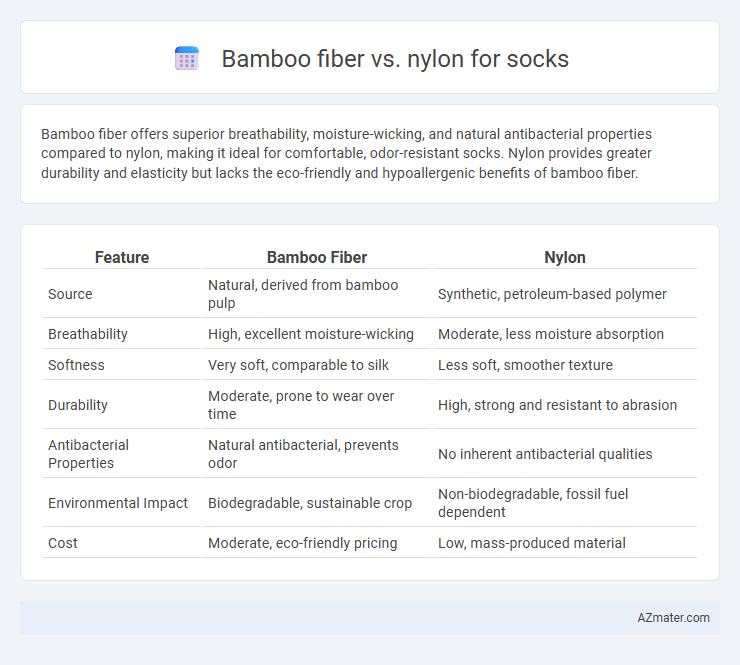Bamboo fiber offers superior breathability, moisture-wicking, and natural antibacterial properties compared to nylon, making it ideal for comfortable, odor-resistant socks. Nylon provides greater durability and elasticity but lacks the eco-friendly and hypoallergenic benefits of bamboo fiber.
Table of Comparison
| Feature | Bamboo Fiber | Nylon |
|---|---|---|
| Source | Natural, derived from bamboo pulp | Synthetic, petroleum-based polymer |
| Breathability | High, excellent moisture-wicking | Moderate, less moisture absorption |
| Softness | Very soft, comparable to silk | Less soft, smoother texture |
| Durability | Moderate, prone to wear over time | High, strong and resistant to abrasion |
| Antibacterial Properties | Natural antibacterial, prevents odor | No inherent antibacterial qualities |
| Environmental Impact | Biodegradable, sustainable crop | Non-biodegradable, fossil fuel dependent |
| Cost | Moderate, eco-friendly pricing | Low, mass-produced material |
Introduction to Bamboo Fiber and Nylon Socks
Bamboo fiber socks offer natural breathability, moisture-wicking properties, and antimicrobial benefits, making them ideal for sensitive skin and active lifestyles. Nylon socks provide exceptional durability, elasticity, and quick-drying capabilities, often blended for enhanced fit and resilience. Choosing between bamboo fiber and nylon depends on the preference for eco-friendly comfort versus long-lasting performance in sock materials.
Material Composition and Origin
Bamboo fiber socks are made from cellulose extracted from bamboo plants, offering a renewable and biodegradable alternative to synthetic fibers. Nylon socks, derived from petroleum-based polyamides, provide high durability and elasticity but are less eco-friendly due to their non-biodegradable nature. Bamboo's natural antimicrobial and moisture-wicking properties contrast with nylon's strength and abrasion resistance, influencing comfort and performance in sock materials.
Comfort and Softness Comparison
Bamboo fiber socks offer superior softness and breathability due to their natural cellulose structure, which helps wick moisture and reduce odor, making them ideal for sensitive skin and all-day comfort. Nylon socks provide durability and elasticity but tend to lack the same level of softness and moisture absorption, often feeling less breathable and more synthetic. For maximum comfort and softness, bamboo fiber socks outperform nylon by delivering a gentle, cushioning touch that enhances foot comfort.
Moisture-Wicking and Breathability
Bamboo fiber excels in moisture-wicking due to its natural hygroscopic properties, absorbing and evaporating sweat quickly to keep feet dry and comfortable. Nylon, although less absorbent, offers superior breathability when engineered with mesh designs, allowing airflow to reduce heat buildup. For socks, bamboo fiber provides a more organic solution for moisture control, while nylon enhances ventilation and durability in active wear.
Durability and Longevity
Bamboo fiber socks offer moderate durability with natural antibacterial properties and moisture-wicking abilities, but they tend to wear out faster than nylon blends under heavy use. Nylon enhances sock longevity by providing excellent abrasion resistance and shape retention, making socks more durable for extended wear and frequent washing. Combining bamboo with nylon creates a balanced fabric that leverages bamboo's comfort and nylon's resilience, resulting in socks that maintain durability and comfort over time.
Odor Resistance and Antimicrobial Properties
Bamboo fiber socks exhibit superior odor resistance and antimicrobial properties compared to nylon socks due to the natural presence of bamboo kun, an agent that inhibits bacterial growth. Nylon, a synthetic fiber, lacks inherent antimicrobial qualities and tends to retain odors after prolonged wear, requiring chemical treatments to improve odor control. Bamboo fiber's natural breathability and moisture-wicking ability further enhance its effectiveness in preventing odor-causing bacteria, making it a preferred choice for odor-resistant socks.
Environmental Impact and Sustainability
Bamboo fiber for socks offers a renewable, biodegradable alternative with lower water usage and pesticide requirements compared to nylon, which is derived from non-renewable petrochemicals and contributes to microplastic pollution. Bamboo cultivation supports soil health and reduces carbon emissions, while nylon manufacturing involves significant energy consumption and releases greenhouse gases. Choosing bamboo fiber over nylon enhances sustainability efforts by minimizing environmental footprints and promoting eco-friendly textile production.
Hypoallergenic Qualities
Bamboo fiber is naturally hypoallergenic and gentle on sensitive skin, making it an excellent choice for socks that reduce irritation and allergic reactions. Nylon, while durable and moisture-wicking, can sometimes cause skin sensitivity or allergies due to its synthetic chemical composition. Choosing bamboo fiber socks enhances comfort and reduces the risk of dermatitis for individuals prone to skin allergies.
Price and Value Analysis
Bamboo fiber socks generally cost more upfront than nylon socks but offer superior moisture-wicking, breathability, and natural antibacterial properties, enhancing long-term value through comfort and durability. Nylon socks, priced lower, provide excellent elasticity and abrasion resistance, making them a cost-effective choice for budget-conscious consumers seeking durability. Evaluating price against performance, bamboo fiber socks deliver higher value in comfort and sustainability, while nylon remains a pragmatic option for affordability and resilience.
Final Verdict: Which is Better for Your Feet?
Bamboo fiber socks offer superior breathability, natural antibacterial properties, and moisture-wicking capabilities, making them ideal for sensitive skin and reducing odor during prolonged wear. Nylon socks excel in durability, elasticity, and quick-drying performance, providing a snug fit and long-lasting support, especially in high-impact activities. Choosing between bamboo fiber and nylon depends on prioritizing comfort and skin health versus enhanced durability and performance.

Infographic: Bamboo fiber vs Nylon for Socks
 azmater.com
azmater.com